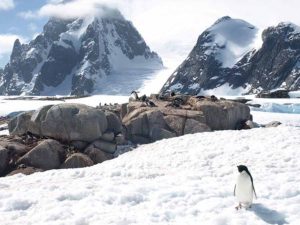
Blue is the colour, blue is the word. The sea deepest blue, the sky azure and soft like Turner pastels, and blue blue ice bobbing on the water.
There isn’t any one reason why Antarctic ice is so blue. The fewer air pockets, the bluer the ice.
The weight of the Antarctic ice and the dryness of the air means it is bluer than what we call ice in the lands where the Gulf stream laps our toes. Then the light shines in on the mountainous ice stack and makes it bluer.
Bluest of all are the segments of iceberg submerged beneath the waves.
The hardest pack ice is the bluest, and looks black from the water. From the bridge of the cruise ship they scan the sea for what they call growlers, hard pressed ice lying low in the water, looking blue from above and black from water level. Hit one of those and you are in trouble.
The blue adds another dimension of beauty, like the sea and skies in a summer holiday postcard. The big landscapes that played on the world’s imagination since the days of Ernest Shackleton are all here, all intact, all exactly unchanged as Shackleton and Tom Crean saw them.
After the Antarctic you feel you will never look at a lump of ice in the same way again.
It is a far cry from your average fly and flop holiday. The end of the long journey for world tourism. Nowadays you can get an Antarctic stamp on your passport. At a small 1950s station you can even buy postcards: what a cool place, wish you were here, doing icily thank you.
It will never be Santa Ponsa but it doesn’t need to be. The numbers of Antarctic tourists are going up and some of the veterans of Route 60 down from Ushuaia are saying it gets crowded down there. They call a stretch of peninsula just below the South Shetland Islands downtown, and the standard stops, the Lemaire Strait, Ronge Island, Peterman Island, Port Lockroy, Antarctic Sound where the tabular icebergs come round the peninsula like battleships in formation, is known as Iceberg Alley in tourist parlance.
Long ago, which in Antarctic tourism terms means 1999, you would rarely meet another ship on these routes. Nowadays you see an occasional cruise ship en route as well as the supply vessels and exploration craft, with grim irony scanning the sea bed for more fossil fuels to accelerate the carbon emissions global warming that threatens to melt the continental ice shelf that brings visitors to the place. The tourist vessels have to book the most popular landing sites so as not to overlap.
At Ushuaia there is a sign on the harbour wall telling you that you are at the end of the world.
Not any more you aren’t, because at any point there are five to six tourist vessels tied up awaiting the run across the Drake Passage to the Antarctic.
Some like the Clipper Adventurer, are the old ex Soviet ice breakers that came available cheaply in the 1990s, refitted as luxury passenger craft. Others are newer, specially built for the region, such as the MV Fram run by Hurtigruten. Even the traditional cruise vessels have started calling by, Crystal Symphony was a visitor during the 2007-8 season, with 900 high-paying passengers in quest of ice that wouldn’t fit in their gin and tonic.
The sea is still big enough for all of them, about 50 ships on the route in a sea bigger than the Mediterranean.
But there is more Antarctic beyond, a vast and untamed continent as large as Australia or the 48 states.
It is the equivalent of cruising to the Cape Cod peninsula and boasting to everyone that you have seen America.
Bringing 400 people to shore is a military scale operation. The tiny zodiac boats that are used for the purpose since the Explorer invented the concept can carry eight people. It is a two hour operation, with boats ferrying passengers in their small groups to and from the landing site.
The groups are called to get ready by number – some ships, like Antarctic Dream, name their groups after explorers.
Each of the 400 togs out like a latter-day Shackleton wannabe: shirt, fleece, windproof jacket, waterproof trousers, two pairs of socks, boots, and life jacket. Even on the sunny day, when the sun can bring temperatures up to a positively balmy four degrees, (don’t be fooled, wind chill always brings it back below freezing) you need to dress for a blizzard.
The weather changes on a penguin dropping here. Without warning the vast Antarctic mountains will dump an ocean load of freezing air on to the foreshore, the mother of all katabatic winds that can halt the landing process and strand visitors ashore for four to twelve hours. Every expedition leader has tales of the tourists who didn’t dress properly and nearly froze to death. The apocryphal mouse trapped by a katabatic.
Everyone over-packs for the Antarctic. We have read too much about Shackleton to under estimate the cold. In the comfort of a modern cruise ship like the Fram with a picture postcard landscape unfolding all around you, you wonder why.
Bring the tee-shirt. It doubles for the bottom layer if the curse of the katabatic strikes your shore.
The landing site too has to be policed. This is a fragile environment and the growing season is short. One footfall on a piece of moss or grass can set it back for years.
The shore party flags out the bits where tourists can and cannot walk. There is a traffic code along the icy paths. Penguins have right of way (like all traffic codes, this is flouted shamelessly by the camera-toting tourists). There is an exclusion zone of five metres from the wildlife, also flouted by the camera wielders.
Although enforced irregularly, the code works. Everyone has a sense of where they belong in the hierarchy, and tourists are on the bottom rung.
The stars of the show are the penguins. With the large colonies, you smell them before you see them. They waddle. They do an extraordinary happy dance, the ecstatic display of legend, where they coo and throw their head back and spread out their chest like someone who has just scored a winning goal. They bicker and gossip and steal the stones from each other’s nests when they have a chance. They fool around with other penguin’s wives. The average day on the Colony would remind you of an afternoon soap or a night in Temple Bar.
You can watch them for hours. The best position is on a rock about fifteen feet away. One penguin squawked and thrashed and threatened to expose her eggs as two neighbours stole stones away from her nest, one by one. When a third would be thief arrived the first two chased it away. It was a drama that would play out until his/her partner returned from feeding. Then he would collect more stones and raid the neighbours when the chance arose.
There are 17 varieties of penguin, and three are found in abundance here. They have always inspired our imagination, their endearing stance, funny walk and the way they eye their human companions. Penguins do not have land predators, so they treat everyone as a friend. The same is not true at sea. When a leopard seal came to call at Half Moon Island we didn’t need to be told by our expedition leaders.
The sea cleared of penguins like someone had announced a shore sale of pickled krill. We didn’t hear the alarm or notice it. A few penguin skeletons, picked clean by seabird after the leopard seal had p-picked up his penguin, warned us all of the consequences of staying too long in the water. Leopard seals don’t stop at penguins. One killed a diver here four years ago.
This isn’t Shackleton’s Endurance expedition, but the danger is never far away. Like a high mountain ski resort if you stray from the piste you are on your own. Five people were killed in ice crevice accidents in October alone.
The Explorer, the Explorer, always the Explorer. Everyone wants to talk about it, its extraordinary demise amid the pack ice off the South Shetlands in November, and the slow listing and sinking of the grand-mammy of Antarctic exploration.
It was a legendary vessel, conceived by legendary Scandinavian explorer Lars-Eric Lindblad. His idea was to bring tourists to places that only scientists ever got to, to give them a series of lectures on history, wildlife and geology as they passed the Drake passage on their way from Ushuaia, to land them in parties on versatile little shore craft and send them home with a seventh continent notched on their belts.
The format remains unchanged. It is hard not to meet someone who worked on the Explorer at some stage. Everyone is from Canada. They know their snow and they know their tourism, and they have gotten to know how Antarctic tourism works before anyone else.
On the year the Explorer went to the bottom, the Antarctic will be visited by 36,000 tourists, a paltry number but seven times the number that came less than a decade ago.
Just three of the 50 ships which make this journey do so on the eastern side of the Antarctic. The journey is longer from Wellington, it turns a two week cruise into a three week cruise, and most are expensive tours, complete with helicopter landings on distant continental sites to view the Emperor penguin. Unfortunately the star of March of the Penguins is in short supply on the western side of the Antarctic.
Most ships take two days to cross the Drake Passage, one of the stormiest stretches of water in the world. Our crossing was an easy one, but dozens of the passengers fell sick.
At the end of the first day you pass the confluence, where the warm water and the cold water collide, and you feel you are there.
It is a headrush of rising excitement for everyone on board, the first albatross, the first iceberg and eventually the arrival. But it is nothing to the landscape fest that is to come.
You carry the images in your head for ever, the outlines of a Minke whale in the clear blue waters below, the sun shimmering on a bay with thousands of broken ice pieces sprinkled on the surface, tall mountains streaked in white with their own private cloud hanging around their necks like bracelets.
Go ashore without the camera. There is too much to see, too much that needs more time than a slave to the lens will allow themselves.
It has been a delicate balancing act between preserving the raw beauty of the Antarctic and tapping its tourist potential, the one resource that might ensure its preservation.
Ian Michael Shaw, a second generation Longford man who travels under an Irish passport, has made 101 voyages to the Antarctic.
He served as expedition leader on the Explorer long before it made its final voyage to the bottom of the sea. Now he works on the Fram, organizing on board lectures on history, wildlife and geology and shore visits.
“Antarctica doesn’t have a voice,” Shaw says. “It doesn’t have an indigenous people to care for it. In a way, the people who visit Antarctica are the closest thing it has. They are the indigenous people of Antarctica and its only real voice – its best hope.”
In his epic “The Worst Journey In The World” Antarctician and war hero Apsley Cherry-Gerrard wrote: “Talk of ex soldiers give me ex Antarctics. Unsoured and with their ideals intact they could sweep the world.”
Shaw has an addendum. “All the people who visit Antarctica are those ex Antarctics and properly motivated, properly organized, they could sweep the world.”
He says that every one who visits the Antarctic has to return as an ambassador to help save the region. Each visit down here has to be more than a belt notch, a postcard home.
Antarctic tourism is the region’s best hope. And because of that its tourists are too. Doing icily, thank you.
Eoghan Corry travelled on the MS Fram, part of the Hurtigruten fleet. Hurtigruten offers a variety of 12 – 21 day Antarctic itineraries including two new voyages for Winter 08/09. www.hurtigruten.ie Tel: 01- 6074420.
Book with Irish specialists Project Travel www.project-travel.ie 01-2108391; Lee Travel 021-4277111; Greystones Travel 01-2874488; John Galligan Travel 01-2076555.



